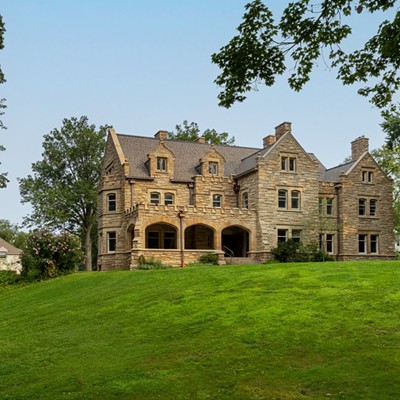Pedestal and Off the Wall -- The two-part title is a sign: This sculpture exhibition, juried by Cleveland artist Don Harvey, boasts a sharply split personality. The meatier, stronger half boldly pushes all sorts of relevant buttons. The second half, by contrast, is pure goofiness -- creative, technically accomplished froth. Guess which half Dietrich Wegner's "Bomber Boy" belongs to? Strapped to this realistic, life-sized figurine of a white, blond-haired little boy is a pack of dynamite. A cherubic symbol of Western innocence transforms into a brainwashed harbinger of death straight from the war-torn Middle East. More than effective, the sculpture jams together opposing stereotypes, thereby evoking an almost painful degree of cognitive dissonance. No less powerful is Case Conover's "Match America." This 3-D map of the U.S., made of matchstick tips, eliminates blue states entirely, brilliantly portraying the entire country as one more-or-less monochromatic swath of red -- one that could, incidentally, burst into flames at the slightest provocation. The show's laid-back side is a zoo of zany contraptions and creatures, dazzling to the eye and playfully meaningless. Chief among them is J. Derek O'Brien's "Polli," a life-sized pig forged from cast-iron cookware. A pig made from pans used for frying bacon? How deliciously cyclical. But Mark VanFleet's "Tape Measure Ceiling" best bridges the gap between the exhibit's two sides: The video shows a group of men extending flimsy tape measures high into the air, allegorically taking the male obsession with length to humorous new heights. Through April 14 at the Sculpture Center, 1834 East 123rd St., 216-229-6527, www.sculpturecenter.org. -- Zachary Lewis
ONGOING
Apart: From Europa to Paradise Lost -- The volatile passion for which Eastern Europe is famous is fully evident in these six large paintings by Clevelander Andrzej Siwkiewicz, a native of Poland. Pretty representation is the last thing on Siwkiewicz's mind as he surrenders to process-as-art mentality and attempts to encapsulate dark, inchoate feelings of alienation, misunderstanding, and life's ultimate futility. Alas, the attempts don't always succeed, despite their sometimes bold visceral appeal. Each painting belongs to one of three recent series: Europa, Separations, or Paradise Lost. To call the differences among the works subtle is an understatement. Essentially, they're all about loneliness, specifically that of someone lost in the gap between two cultures. It's easy to imagine a dramatic scenario behind Europa's "Escape From the Market at Noon," the show's most vigorously painted image: Suddenly inspired by some deep-seated passion, the artist dashes home and releases the floodgates of his subconscious onto canvas. What results is an explosion of whitish flames over ribbons of red the color of meat. Perhaps it's no surprise to detect a pink, vaginal oval in this heated mix. It's not all pure abstraction. Pale, skeleton-like figures cross a white, slatted pathway in "Bridge of Suspend," of the Paradise Lost series. But Siwkiewicz reduces everything to two dimensions. Thus the limp, faceless creatures appear pinned to the painting's red background. What they're doing is more like dangling than crossing. The frustration message is clear. Problem is, that's where the communication ends. Through March 31 at Exit: a Gallery Space, 2688 West 14th St., 330-321-8161, www.exitgallery.com. -- Lewis
Monet in Normandy -- Claude Monet's oeuvre has been presented a thousand times in a thousand ways, but never quite like this. Organized chronologically in accordance with Monet's many trips to France's rugged Normandy coast, and featuring a healthy mix of major and minor works, this 50-piece exhibition amounts to a quick but insightful examination of the painter's stylistic development. Famous works from the 1860s like "The Garden at Sainte-Adresse" and "Pointe de la Heve at Low Tide" illuminate the show's early chapter, in which Monet becomes infatuated with the sea and refines his ability to produce landscapes both fresh and dramatic. But it's not long until Monet's nascent Impressionism begins to emerge. By the 1880s, after marriage and many returns to the shore, his palette is growing more subtle and complex, and he's more intensely obsessed with water. One painting here, full of blue-green curlicues depicting crashing waves, verges on pure abstraction. This tendency is even more pronounced by the 1890s. "Gorge of the Petit Ailly," from 1897, is an ethereal landscape dominated by shades of pink, light green, and yellow, masterfully blended. All this is mere prelude, of course, to the water lilies of Giverny, and those attending just for these paintings won't be disappointed by the grand examples here. But the most rewarding pieces are those that show Monet's devotion to capturing the transformative effects of light, shadow, and snow. The few precious selections from the Rouen cathedral and haystack series are enough to steal this already dazzling show. Through May 20 at the Cleveland Museum of Art, 11150 East Boulevard, 216-421-7350, www.clevelandart.org. -- Lewis
Side by Side -- Group showcases of Cleveland-area talent are fairly common. Few exhibits, however, achieve persuasive coherence as this 10-artist show does, with related works that rub shoulders. It's not a gimmick. While most of the artists here have plenty to offer individually, the show's layout provides additional, insightful context, placing each piece along a spectrum illuminating both its uniqueness and its connections to its neighbors. At first, Laurie Addis' intricate linen weavings bear no resemblance to Neil MacDonald's pixilated landscapes of Salton Sea, an ecologically ruined lake in Southern California. But both rely on distance to achieve their effects. Like Impressionism in reverse, Addis' work gets better close up; wild variety and density of stitching emerges out of seemingly solid patches of dark, earthy colors. By contrast, distance brings MacDonald's images into sharper focus: Fragmentation and graininess coalesce into scenes of devastating decline and waste. From here, the leap to Mark Moskovitz's clever "Future Perfect" is not far. It also addresses environmental concerns. Biologically speaking, this large white bench made from plastic and polyester cord is going nowhere. But, like the earth itself, it isn't too late to avert disaster. The bench will decompose, if only it gets recycled. Pure abstraction is one major terminus of this artistic line, and Gianna Commito's complex geometric designs represent that end handily, ingeniously inducing three-dimensionality and drawing the eye into deep visual vortices with a force similar to the one holding the entire show together. Through May 13 at the Museum of Contemporary Art, 8501 Carnegie Ave., 216-421-8671, www.mocacleveland.org. -- Lewis
Transplant -- If you like your cartoons with a hard edge, this exhibit by four local graphic designers who are not originally from Cleveland -- Jorge Lacera, Dave Savage, Saxton Moore, and Carlos Villagra -- will go down as easily as spiked punch. But in addition to a whole lotta dark, slightly twisted fun and crackling creativity, the show offers the pleasure of real variety. Only Lacera addresses the theme head-on: A native of Colombia, raised in Miami, and recently hired in Cleveland, he truly is a foreigner. Doubtless he sees himself in his characters, drawn in marker on wood: gangly, rubber-limbed robots striding confidently over cities -- like Godzilla, only more detached and superior. They clearly aren't dangerous, not with doe eyes and walrus-like faces. Savage, native of Missouri, takes prizes for humor and boldness. His digitally conceived creatures light up the room with crisp, bright colors and raunchy one-liners. Spiritual descendants of Garbage Pail Kids, they're bitter, sarcastic, and self-aware little devils. One clean example: a gigantic-nosed girl asks us to somehow note her spontaneous side. Villagra's work is bleaker and more sadistic, full of impaled or disemboweled figures. His mistrustful view is summarized in four Classical-style portraits, each with its corresponding inner monster. Villagra's own noble features apparently mask an evil Nazi vampire. For monsters of a different kind, visit Asterisk's lower gallery. There you'll find emerging artist Ervin Williams III's glitzy portraits of the pop stars we worship. Through April 13 at Asterisk Gallery, 2393 Professor Ave., 330-304-8528, www.asteriskgallery.com. -- Lewis
Visions of a City With Soul -- Eighty years of life in Cleveland come alive in this ample survey of four photographers: Arthur Gray, William Barnhill, Jasper Wood, and Andrew Borowiec. What's striking is how different these artists are. Beyond using black-and-white film, they have almost nothing in common. Gray, in the 1920s, fondly captures Cleveland's economic heyday, when downtown was a vibrant, crowded shopping district and black smoke symbolized industrial health. But while his work is dated, it's also strikingly contemporary in certain respects. "Bridges at Night," a long exposure illustrating the curvy paths of traffic through and over the Flats, might have been taken yesterday. Wood, a self-taught artist in the late '40s, exposes Cleveland's extreme poverty with brutal honesty; his shots of unemployed men and grimy children playing in garbage-strewn slums burn into the visual memory instantaneously. Urban loneliness, expressed via desolate, shadowy alleyways, seems to have been Barnhill's primary interest in the late '30s. But Borowiec, a professor at the University of Akron, has the sharpest formal eye. Shooting in modern-day western Cleveland, Borowiec composes scenes of remarkable depth and geometric eclecticism. Lines formed by train tracks, beams, and industrial structures intersect at every angle, setting up one surprising contrast after another. Perfect regularity, though, is what distinguishes his "Bridge Street, Ohio City." These hanging plants, evenly distributed over someone's chain-link fence, are almost too precise to be real -- oases of consistency in an inconsistent world. Through March 31 at the Cleveland Artists Foundation (at Beck Center for the Arts), 17801 Detroit Ave., Lakewood, 216-227-9507, www.clevelandartists.org. -- Lewis











